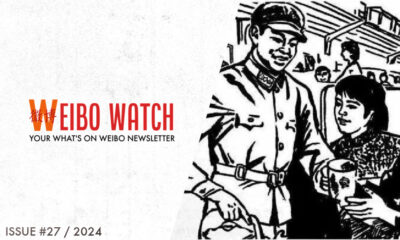China Brands, Marketing & Consumers
Social Media in Times of China’s Flood Disaster: Participation, Profits, and Propaganda
Published
3 years agoon
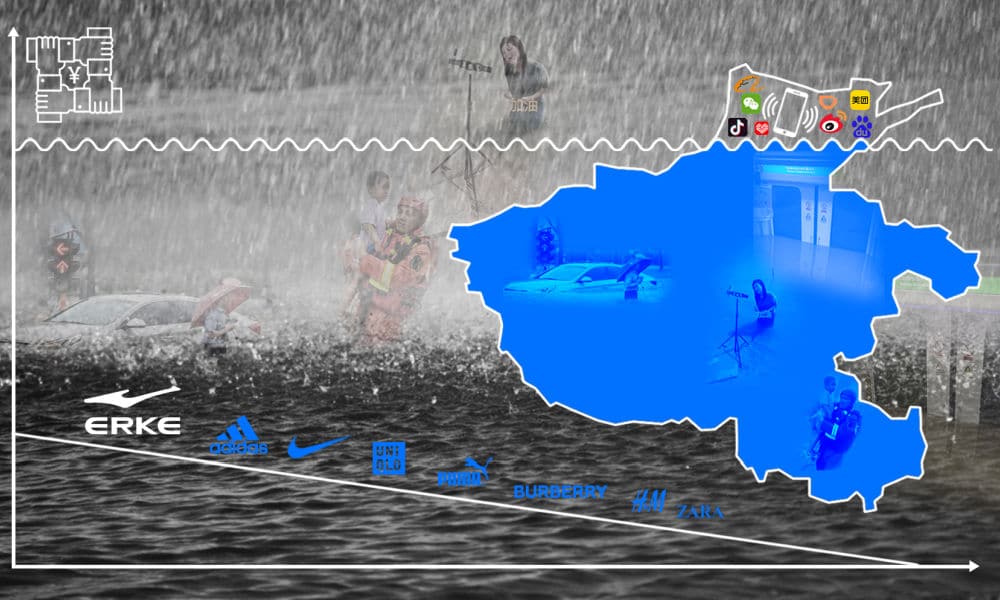
The social media trends during China’s heavy rainfall and floods in July of 2021 show the multidimensionality of online communication in times of disaster. Facing the devastating downpours, Weibo became a site for participation, propaganda, and some controversial profiting.
This is the “WE…WEI…WHAT?” column by Manya Koetse, original publication in German by Goethe Institut China, visit Yi Magazin: WE…WEI…WHAT? Manya Koetse erklärt das chinesische Internet. Read this article in German here.
Starting on July 17, 2021, China’s Henan Province experienced extreme rain that led to record-breaking flooding and soon forced thousands of people to leave their homes, completely disrupting normal life.
Several places in the region saw unprecedented rainfall. From 8pm on July 19 to 8pm on July 20, the provincial capital Zhengzhou experienced 552.2 mm of rainfall, which is 3.5 times more rain than Germany saw during its heaviest rainfall in 75 years on July 14-15 of this year.
The death toll from the torrential rainfall has risen to at least 302 people, with many remaining missing.
As emergency situations occurred across the region, social media came to play an important role in the response to the natural disaster. Weibo, one of China’s biggest social media sites, was utilized as a communication tool during the floods by regular netizens, official channels, and companies.
While the extreme weather continued, the Henan flood disaster played out on social media in various ways. There were those helping, those profiting, and then there were those profiting from helping. We will highlight some of these dimensions within the social media responses to Henan’s catastrophic floods here.
People Helping People
There is one hashtag on Weibo that was breaking records in July: ‘Help Each Other During Henan Rainstorm’ (#河南暴雨互助#) received a staggering 16.9 billion clicks just a week after it was first launched.
By creating an online ‘Henan Help’ community, Weibo facilitated active public participation in providing immediate assistance to those affected by the extreme weather and flooding.
As described by Wendy Huang for What’s on Weibo (link), an enormous volume of messages starting pouring in on Chinese social media since the start of the heavy rainfall from people disseminating relevant information on available resources and from those seeking and providing assistance.
Rather than being a messy collection of individual posts, netizens collectively participated in verifying, summarizing, highlighting, and spreading the online help requests posted by people from different locations. In doing so, they helped in speeding up the rescue work.
This is not the first time for Weibo to play an important role during a crisis or emergency. When Sichuan Province was hit by a deadly earthquake in 2013, social media enabled a fast and free grass-roots response to the disaster. The Sina Weibo platform allowed for efficient, immediate crisis communication, leading to teams of volunteers – organized via Weibo – heading out to the disaster zone to deliver donated tents, blankets, water, etc. and provide other forms of assistance (Levin 2013).
During the early stages of the Wuhan COVID19 outbreak, social media platforms such as Weibo and WeChat were also used as practical communication tools for organizations and individuals to spread information or to ask for help. One example is how Weibo helped local volunteers organize teams to assist in taking care of people’s left-behind pets when they were unable to return to their homes due to quarantine or hospitalization.
As soon as the scale of the floods in Henan province became clear, social media users started donating money for flood relief efforts. By July 21st, while the videos of the devastating impact of the heavy rainfalls went viral, Weibo users had already contributed 20 million yuan ($3 million). That number soon rose significantly as more netizens, social influencers, and celebrities also started to donate and promote charity foundations.
Simply posting, replying, forwarding, and making comments itself was also a way of public participation during the Henan floods. While many news reports and social media posts were focused on what was going on in the provincial capital of Zhengzhou, the people in the more rural areas such as Weihui in Xinxiang started sounding the alarm by July 21st, pleading for netizens to pay more attention to their situation so that it would also enter the top trending lists. Sharing these posts to draw more attention to them also became a way of providing assistance.
By July 21st, half of Weibo’s top trending topics were related to the Henan floods.
Showing Support and Showing Off
Chinese netizens made a huge impact on how the Henan flood disaster was handled in the early stages, but companies in China also contributed to flooding relief efforts in many ways, while their actions simultaneously served PR goals.
On July 21st, one major company after the other announced its donation via social media. Tech giants Pinduoduo, Tencent, Meituan, Didi, and Bytedance all donated 100 million yuan ($15.4 million) each to help the rescue operations in Henan. Alibaba topped the list with a 150 million ($23 million) donation.
Besides donating 30 million yuan ($4.6 million), Chinese tech giant Huawei also sent a team of 187 engineers to provide assistance on the front line and 68 of their R&D experts worked on helping local operators in their network repair and maintenance work to ensure a smooth communication network in the disaster area.
The Henan floods also provided an opportunity for Western brands in China to win back public favor. Many Western companies triggered outrage in China earlier this year over their ban on cotton from Xinjiang (link). In light of the Henan catastrophe, Nike and Adidas each contributed 20 million yuan ($3 million), Uniqlo 10 million ($1.5 million), PUMA 5 million ($773,000), Burberry 1.5 million yuan ($230,000), and Zara and H&M each donated 1 million ($155,000).
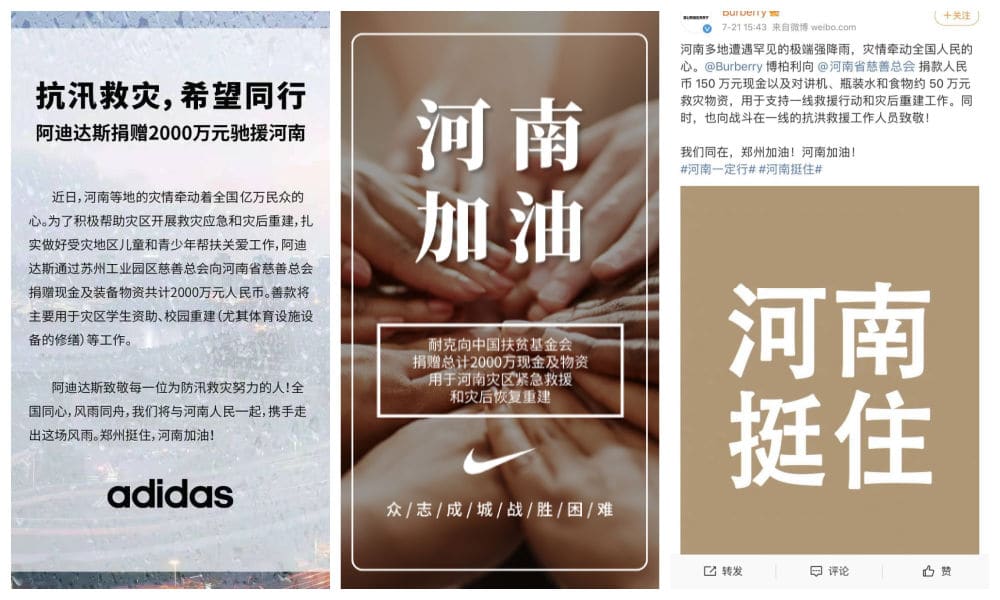
Adidas, Nike, and Burberry announcing their donations via social media.
Their contributions, however, did not seem to do much for their public image. The donations barely received media coverage, and some social media users who did know about them complained that Zara and H&M did not give enough money. There were also many netizens who praised Chinese sportswear brands for donating money and condemned Nike for giving “zero yuan,” even though the company had already announced donating 20 million yuan.
The company that really managed to win the public’s favor through their Henan donation is Erke (鸿星尔克 ), a relatively small and low-key Chinese sportswear company that seemingly was not doing too well over the past year facing great domestic competition.
When Erke donated 50 million yuan ($7.7 million) to the Henan flood relief efforts, it attracted major attention on Chinese social media. The sportswear brand donated an amount that was ten times higher than, for example, the donation made by major coffee company Starbucks.
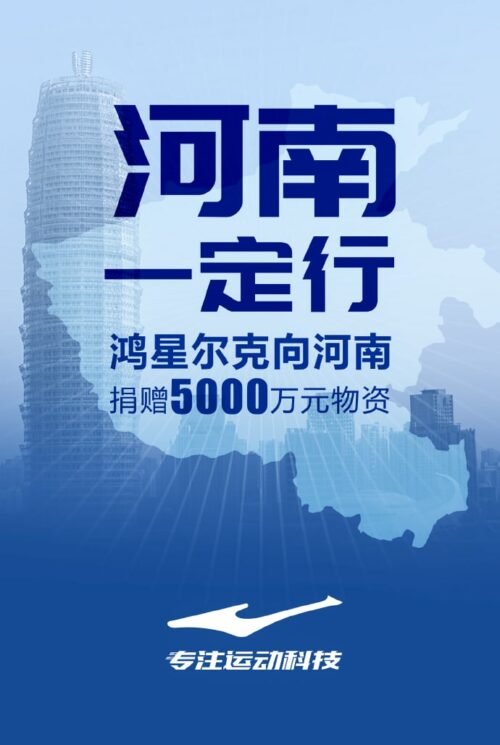
Erke announcing its donation via social media (Weibo).
After people found out that the Erke brand donated such a high amount of money to help the people in Henan despite its own losses, its sales went through the roof – everyone wanted to support this generous ‘patriotic brand.’ While netizens rushed to the online shops selling Erke, the brand’s physical shops also ran out of products with so many people coming to buy their sportswear. Some sales assistants were moved to tears when the store suddenly filled up with customers.
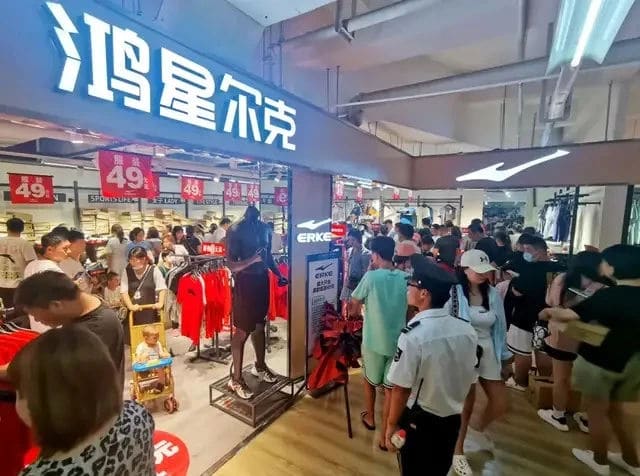
People lining up at an Erke shop, photo via UDN.com.
The Erke hype even went so far that Chinese livestream sellers of Nike and Adidas notified their viewers that they actually supported the domestic Erke brand.
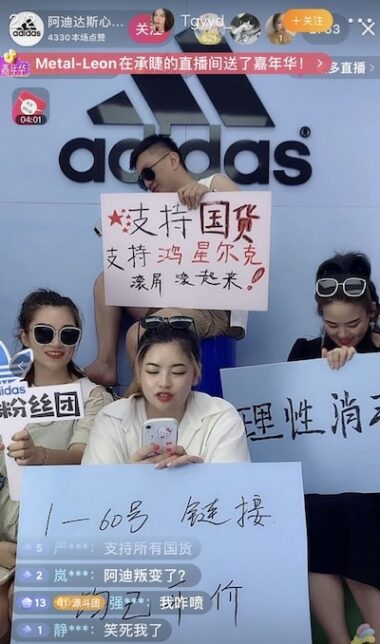
Adidas livestream sellers supporting Erke.
Erke profited from helping Henan, but there were also those companies that wanted to profit from the Henan floods without actually helping.
One ad by the local real estate company Kangqiao Real Estate promoting its ‘high lands’ properties led to online controversy. The Kangqiao Group poster highlighted the height advantage to its real estate locations, using the slogan: “Highland – live in the highland and only let the wind and rain be your scenery.”
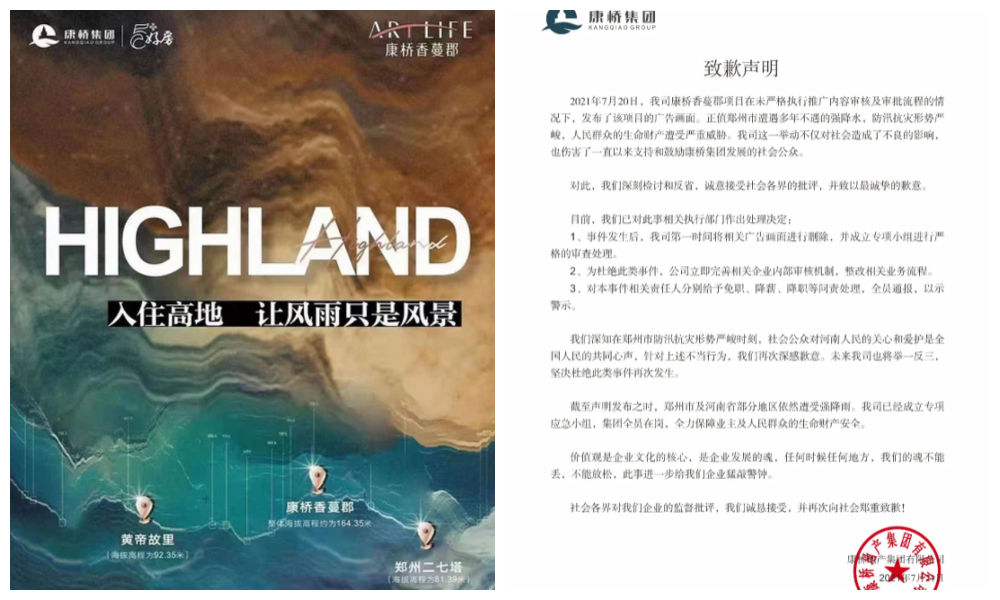
The company apologized for its insensitive marketing campaign on July 21st, the hashtag (#康桥地产致歉#) received over 130 million views, but the damage to its reputation had already been done. In a similar fashion, two other companies also promoted their “safe” real estate and parking lots during the Henan floodings, with one company using a photo of a flooded car in Henan to suggest what could happen when not using their services. It led to online outrage that these companies would use such a disastrous time for their own marketing purposes.
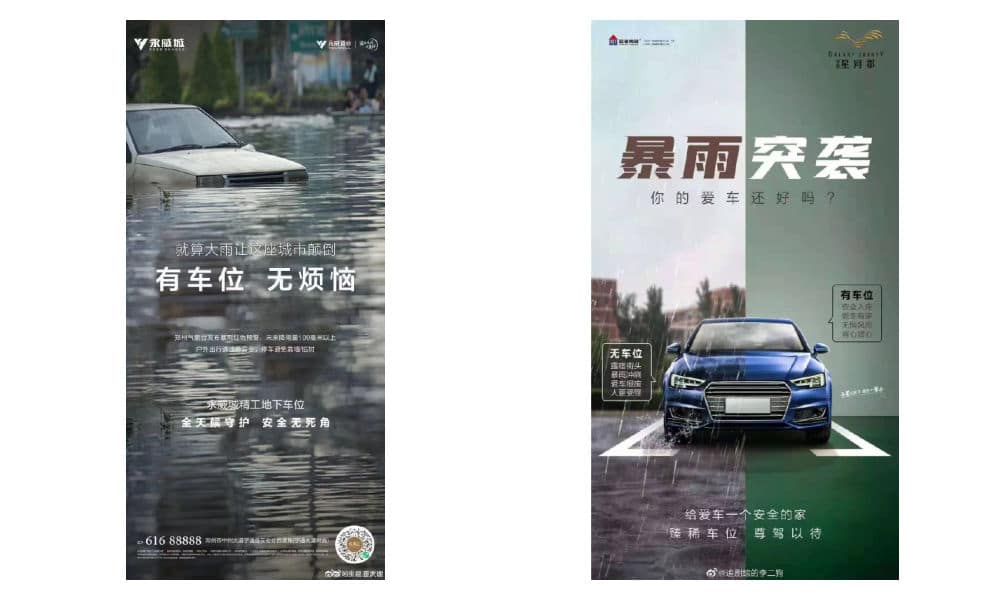
Other examples of people using the floods for their own publicity also went trending on social media, such as a group of Chinese online influencers who came to affected areas to record themselves, making a show out of the floods (photos below).




On July 27, some online influencers even went one step further to promote their channels and boost viewership. They traveled to Weihui, one of the province’s worst affected areas, and shamelessly stole a rescue boat, and headed into the waters without actually helping anyone. The incident prevented actual aid workers from doing their job and delayed the rescue work by four hours. It caused controversy on Weibo (#网红为拍视频偷救生艇谎称去救人#), with many wondering why these people would want to profit from a situation that was still so critical.
There were also online discussions on situations in which it was less clear to what extent people were in it for ‘the show.’ Chinese celebrities Han Hong (韩红) and Wang Yibo (王一博) both traveled to the affected areas for their charity work, but they were then accused of using the disaster for their own PR benefits. Many did not agree, saying they were “moved by their patriotism.”
Official Media Promoting National Solidarity
Most hashtags, videos, and trending topics on Weibo from the early moments of the rainfall and floods were initiated by regular netizens. Many people in the affected regions posted photos and videos of the local scenes themselves.
When the cars of the Zhengzhou subway line 5 were submerged in water due to flash floods on July 20, over 500 passengers were trapped. Footage of people in the carriages standing in chest-deep water that was still rising circulated on social media as rescue efforts were underway. Some hours later, rescuers managed to get people out safely, but 14 people did not make it out alive.
These kinds of unfolding events and tragedies were posted and reported on social media in real time by bloggers. Although official media channels and government accounts were also active in reporting incidents and releasing timely information, they soon focused on sending out a message of national unity and emphasized successful rescue operations and the competency of China’s relief efforts.
A similar approach to crisis communication on social media was seen during the outbreak of COVID19 and in other emergency situations – it is a route that has been taken for many years in the Party’s partnership with the media. In Media Politics in China (2017), author Maria Repnikova writes about the response to the Wenchuan earthquake (2008) when she points out how most official coverage concerning crisis management positively portrays the state’s rescue efforts and utilizes emotional projection of national unity and resilience, conveying an overall positive and people-centered narrative (118-121).
This patriotic discourse was also adopted in the social media coverage of the Henan floods by official channels. State media outlets were in unison in promoting hashtags such as “Stand Strong, Henan, We’re Coming” (#河南挺住我们来了#), “Zhengzhou, Hold On!” (#郑州挺住#), or “Shouldering Together with Henan” (#和河南一起扛#).
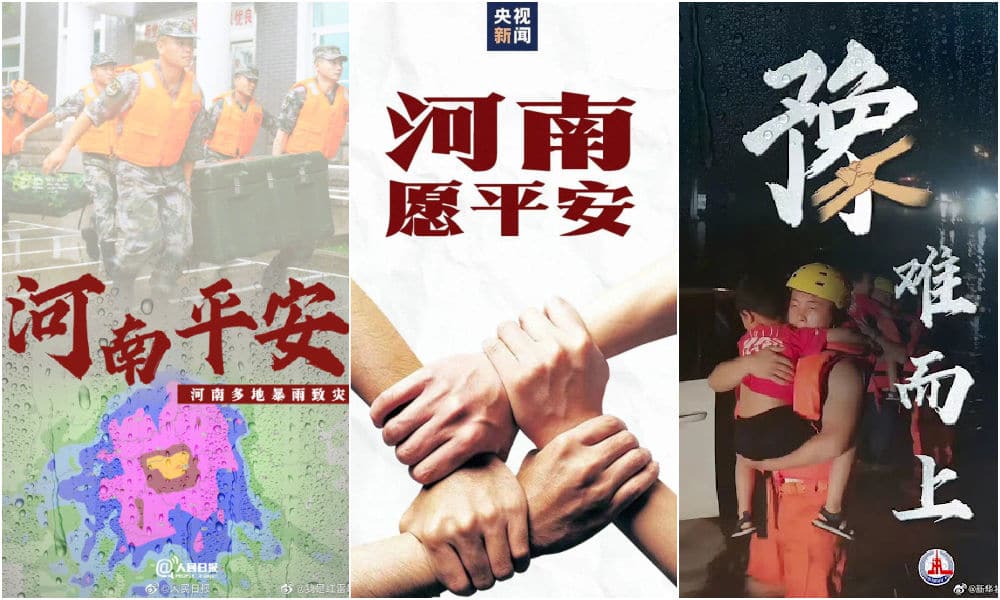
Online posters for the Henan Floods by CCTV, People’s Daily, and Xinhua.
In their news reporting, official media channels especially spotlighted people-centered stories. Some examples include the story of a 17-year-old boy who cried as he hugged the firefighter who rescued him, the news item on a 3-month old baby who was pulled from the ruins of a collapsed house in Xingyang, or the account of a Zhengzhou policeman who was so dedicated to his work that he hadn’t returned home in over 30 hours.
By July 21st, official Party newspaper People’s Daily had launched a hashtag titled “Touching Scenes of People Helping Each Other” (#河南暴雨中的感人互助画面#), which showed photos and videos of citizens working together in rescuing people from the water.
Another Weibo hashtag was titled “The Power of China during the Henan Rainstorms” (#河南暴雨中的中国力量#), which focused on the solidarity and compassion of the thousands of volunteers and rescue workers, stressing the idea that the people of China are able to get through difficulties together.
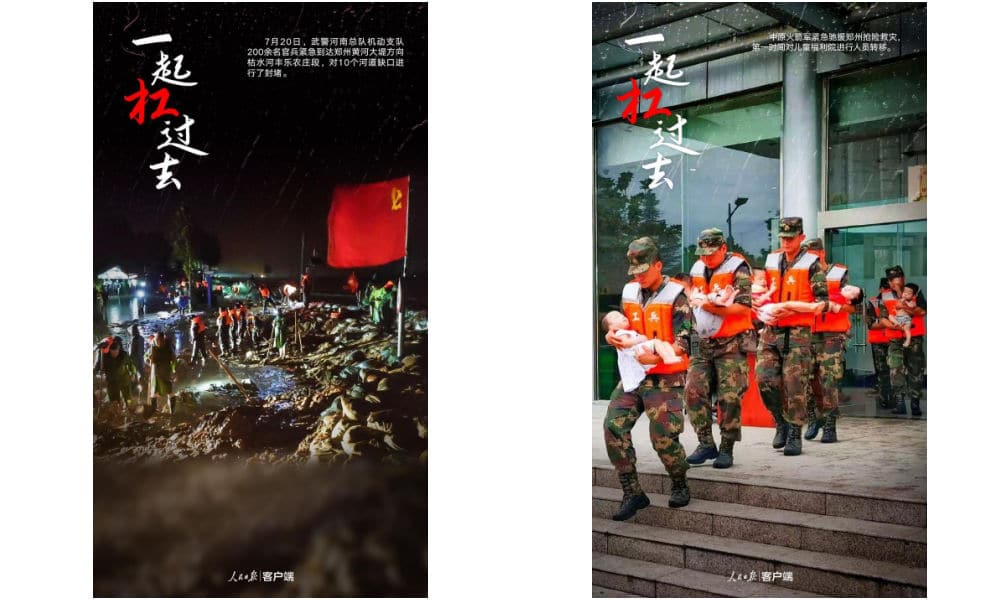
“We can get through this together,” online posters by People’s Daily.
The main message that is propagated by Chinese official media and government on social media is one that resonates with the general Weibo audience. Standing together with Henan and uniting in times of disaster is a sentiment that is strongly supported, not just by official channels, but by netizens, celebrities, and companies alike.
As the floods and relief efforts are still continuing in various parts of Henan Province, the messages of support and online assistance are ongoing. “Come on, Henan!” is the slogan that is sent out everywhere on Weibo, with people staying positive: “We can do this together. Everything is going to be alright.”
By Manya Koetse
Follow @whatsonweibo
References:
Levin, Dan. 2013. “Social Media in China Fuel Citizen Response to Quake.” New York Times, May 11 https://www.nytimes.com/2013/05/12/world/asia/quake-response.html [7.30.21].
Repnikova, Maria. 2017. Media Politics in China: Improvising Power under Authoritarianism. Cambridge: Cambridge University Press.
This text was written for Goethe-Institut China under a CC-BY-NC-ND-4.0-DE license (Creative Commons) as part of a monthly column in collaboration with What’s On Weibo.
Spotted a mistake or want to add something? Please let us know in comments below or email us. First-time commenters, please be patient – we will have to manually approve your comment before it appears.
Manya Koetse is the founder and editor-in-chief of whatsonweibo.com. She is a writer, public speaker, and researcher (Sinologist, MPhil) on social trends, digital developments, and new media in an ever-changing China, with a focus on Chinese society, pop culture, and gender issues. She shares her love for hotpot on hotpotambassador.com. Contact at manya@whatsonweibo.com, or follow on Twitter.

China Brands, Marketing & Consumers
Zara Dress Goes Viral in China for Resemblance to Haidilao Apron
Who’s gonna buy this Zara dress in China? “I’m afraid that someone will say I stole the apron from Haidilao.”
Published
1 week agoon
April 19, 2024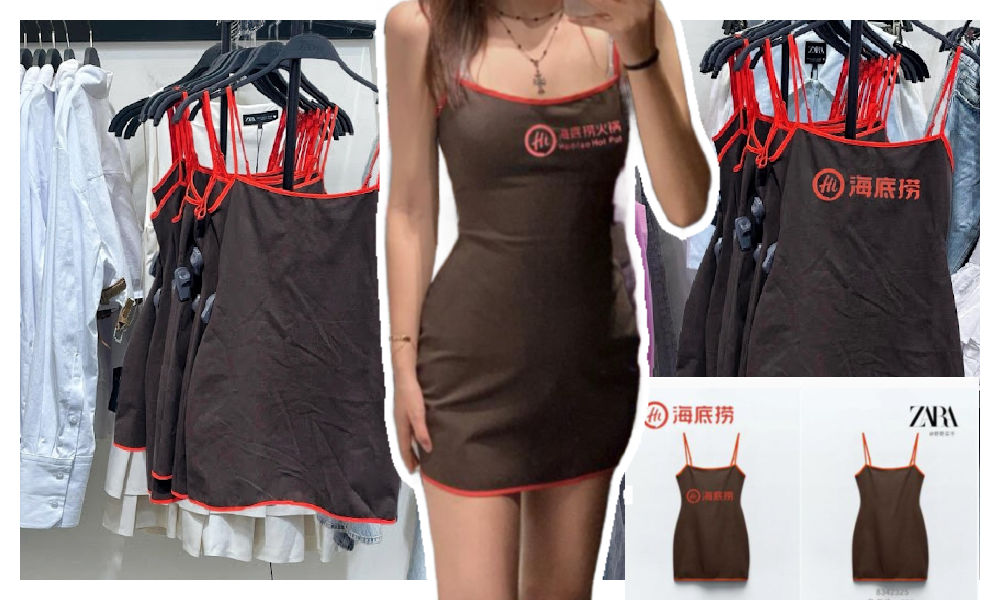
A short dress sold by Zara has gone viral in China for looking like the aprons used by the popular Chinese hotpot chain Haidilao.
“I really thought it was a Zara x Haidialo collab,” some customers commented. Others also agree that the first thing they thought about when seeing the Zara dress was the Haidilao apron.
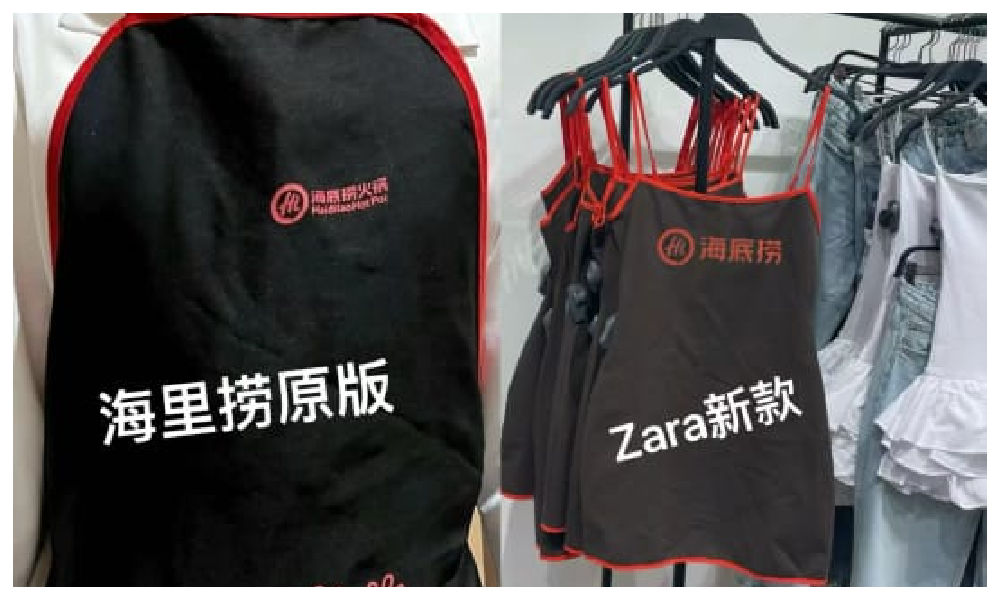
The “original” vs the Zara dress.
The dress has become a popular topic on Xiaohongshu and other social media, where some images show the dress with the Haidilao logo photoshopped on it to emphasize the similarity.

One post on Xiaohongshu discussing the dress, with the caption “Curious about the inspiration behind Zara’s design,” garnered over 28,000 replies.
Haidilao, with its numerous restaurants across China, is renowned for its hospitality and exceptional customer service. Anyone who has ever dined at their restaurants is familiar with the Haidilao apron provided to diners for protecting their clothes from food or oil stains while enjoying hotpot.
These aprons are meant for use during the meal and should be returned to the staff afterward, rather than taken home.
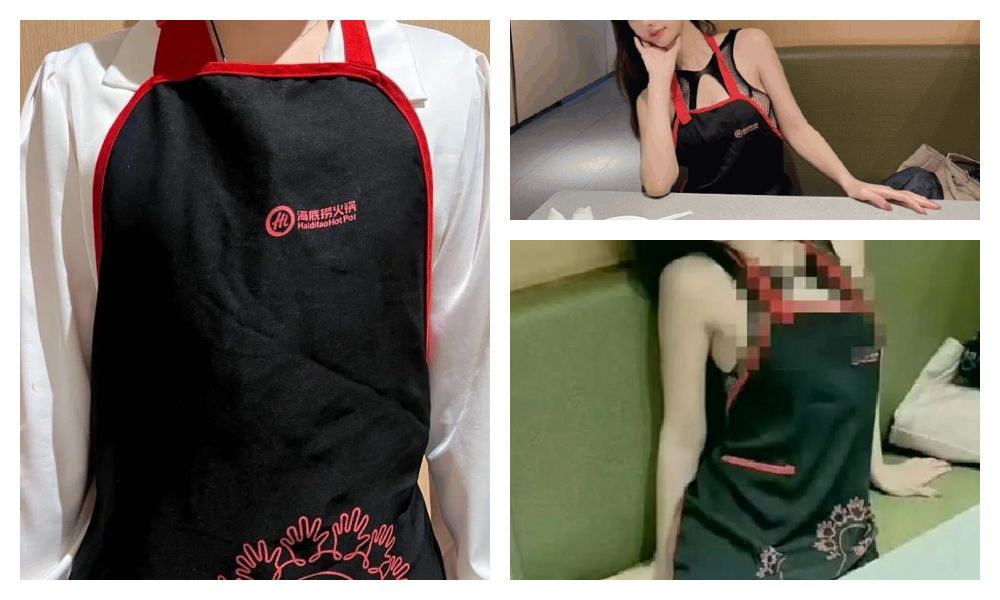
The Haidilao apron.
However, many people who have dined at Haidilao may have encountered the following scenario: after indulging in drinks and hotpot, they realize they are still wearing a Haidilao apron upon leaving the restaurant. Consequently, many hotpot enthusiasts may have an ‘accidental’ Haidilao apron tucked away at home somewhere.
This only adds to the humor of the latest Zara dress looking like the apron. The similarity between the Zara dress and the Haidilao apron is actually so striking, that some people are afraid to be accused of being a thief if they would wear it.
One Weibo commenter wrote: “The most confusing item of this season from Zara has come out. It’s like a Zara x Haidilao collaboration apron… This… I can’t wear it: I’m afraid that someone will say I stole the apron from Haidilao.”

Funnily enough, the Haidilao apron similarity seems to have set off a trend of girls trying on the Zara dress and posting photos of themselves wearing it.
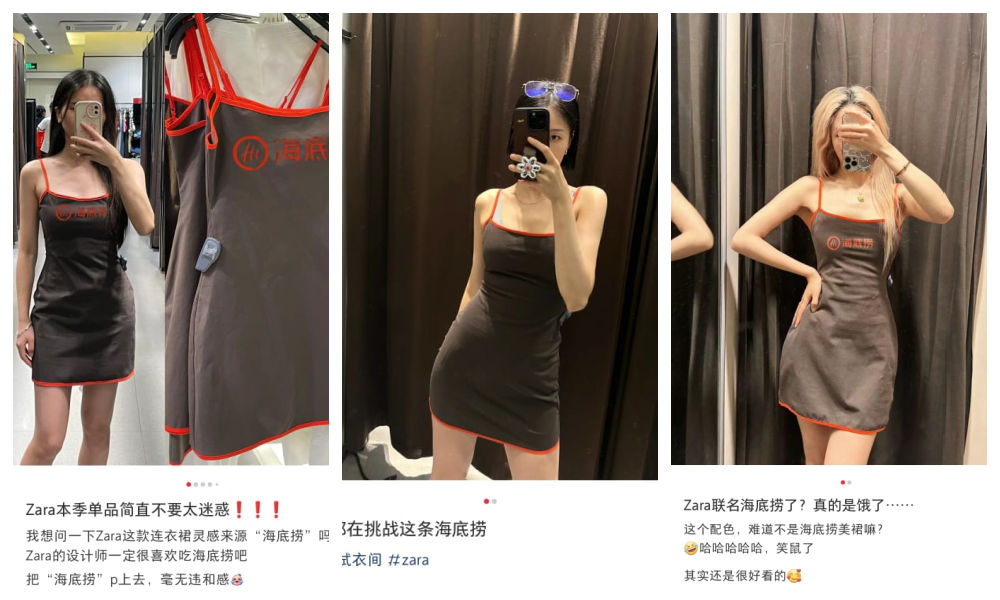
It’s doubtful that they’re actually purchasing the dress. Although some commenters say the dress is not bad, most people associate it too closely with the Haidilao brand: it just makes them hungry for hotpot.
By Manya Koetse
Independently reporting China trends for over a decade. Like what we do? Support us and get the story behind the hashtag by subscribing:
Spotted a mistake or want to add something? Please let us know in comments below or email us. First-time commenters, please be patient – we will have to manually approve your comment before it appears.
©2024 Whatsonweibo. All rights reserved. Do not reproduce our content without permission – you can contact us at info@whatsonweibo.com.
China Brands, Marketing & Consumers
More than Malatang: Tianshui’s Recipe for Success
Zibo had its BBQ moment. Now, it’s Tianshui’s turn to shine with its special take on malatang. Tourism marketing in China will never be the same again.
Published
4 weeks agoon
April 1, 2024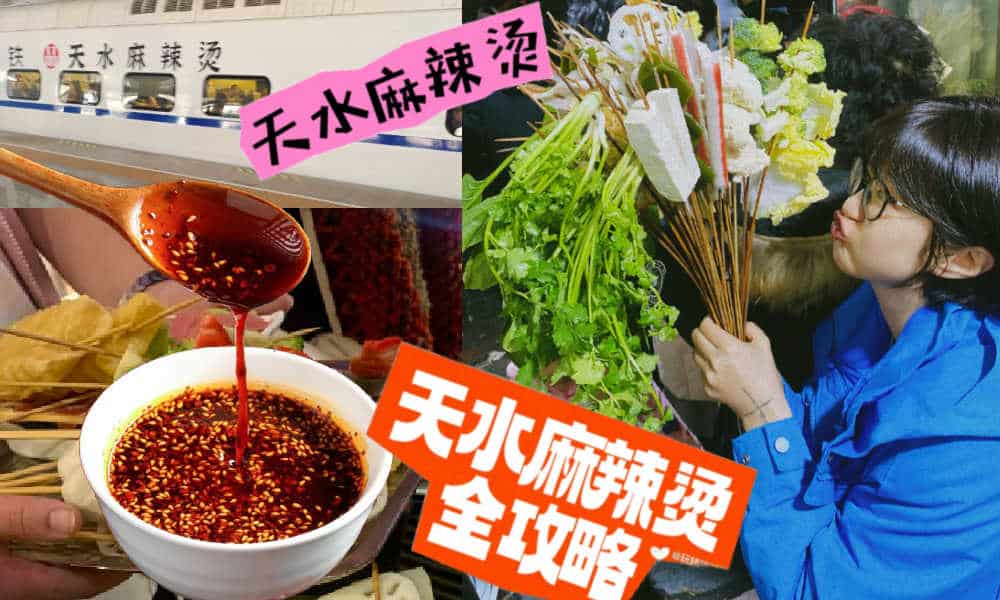
Since the early post-pandemic days, Chinese cities have stepped up their game to attract more tourists. The dynamics of Chinese social media make it possible for smaller, lesser-known destinations to gain overnight fame as a ‘celebrity city.’ Now, it’s Tianshui’s turn to shine.
During this Qingming Festival holiday, there is one Chinese city that will definitely welcome more visitors than usual. Tianshui, the second largest city in Gansu Province, has emerged as the latest travel hotspot among domestic tourists following its recent surge in popularity online.
Situated approximately halfway along the Lanzhou-Xi’an rail line, this ancient city wasn’t previously a top destination for tourists. Most travelers would typically pass through the industrial city to see the Maiji Shan Grottoes, the fourth largest Buddhist cave complex in China, renowned for its famous rock carvings along the Silk Road.
But now, there is another reason to visit Tianshui: malatang.
Gansu-Style Malatang
Málàtàng (麻辣烫), which literally means ‘numb spicy hot,’ is a popular Chinese street food dish featuring a diverse array of ingredients cooked in a soup base infused with Sichuan pepper and dried chili pepper. There are multiple ways to enjoy malatang.
When dining at smaller street stalls, it’s common to find a selection of skewered foods—ranging from meats to quail eggs and vegetables—simmering in a large vat of flavorful spicy broth. This communal dining experience is affordable and convenient for solo diners or smaller groups seeking a hotpot-style meal.
In malatang restaurants, patrons can usually choose from a selection of self-serve skewered ingredients. You have them weighed, pay, and then have it prepared and served in a bowl with a preferred soup base, often with the option to choose the level of spiciness, from super hot to mild.
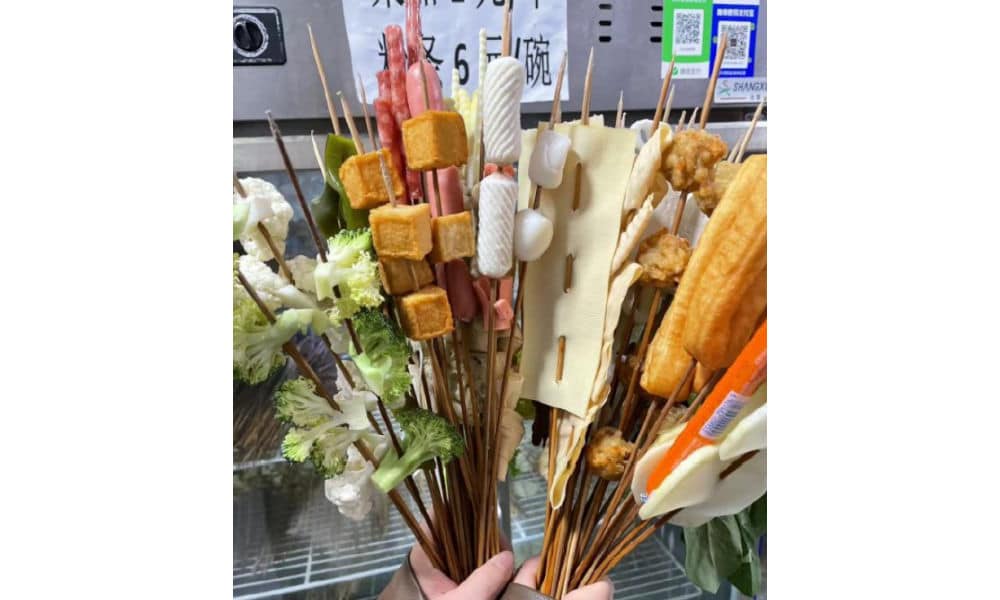
Although malatang originated in Sichuan, it is now common all over China. What makes Tianshui malatang stand out is its “Gansu-style” take, with a special focus on hand-pulled noodles, potato, and spicy oil.
An important ingredient for the soup base is the somewhat sweet and fragrant Gangu chili, produced in Tianshui’s Gangu County, known as “the hometown of peppers.”
Another ingredient is Maiji peppercorns (used in the sauce), and there are more locally produced ingredients, such as the black fungi from Qingshui County.
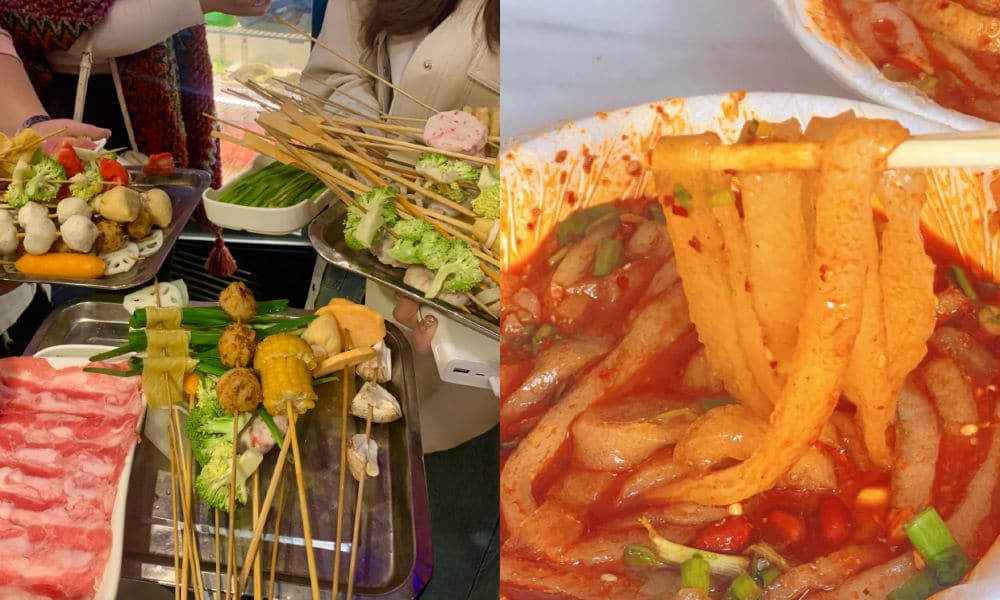
One restaurant that made Tianshui’s malatang particularly famous is Haiying Malatang (海英麻辣烫) in the city’s Qinzhou District. On February 13, the tiny restaurant, which has been around for three decades, welcomed an online influencer (@一杯梁白开) who posted about her visit.
The vlogger was so enthusiastic about her taste of “Gansu-style malatang,” that she urged her followers to try it out. It was the start of something much bigger than she could have imagined.
Replicating Zibo
Tianshui isn’t the first city to capture the spotlight on Chinese social media. Cities such as Zibo and Harbin have previously surged in popularity, becoming overnight sensations on platforms like Weibo, Xiaohongshu, and Douyin.
This phenomenon of Chinese cities transforming into hot travel destinations due to social media frenzy became particularly noteworthy in early 2023.
During the Covid years, various factors sparked a friendly competition among Chinese cities, each competing to attract the most visitors and to promote their city in the best way possible.
The Covid pandemic had diverse impacts on the Chinese domestic tourism industry. On one hand, domestic tourism flourished due to the pandemic, as Chinese travelers opted for destinations closer to home amid travel restrictions. On the other hand, the zero-Covid policy, with its lockdowns and the absence of foreign visitors, posed significant challenges to the tourism sector.
Following the abolition of the zero-Covid policy, tourism and marketing departments across China swung into action to revitalize their local economy. China’s social media platforms became battlegrounds to capture the attention of Chinese netizens. Local government officials dressed up in traditional outfits and created original videos to convince tourists to visit their hometowns.
Zibo was the first city to become an absolute social media sensation in the post-Covid era. The old industrial and mining city was not exactly known as a trendy tourist destination, but saw its hotel bookings going up 800% in 2023 compared to pre-Covid year 2019. Among others factors contributing to its success, the city’s online marketing campaign and how it turned its local BBQ culture into a unique selling point were both critical.
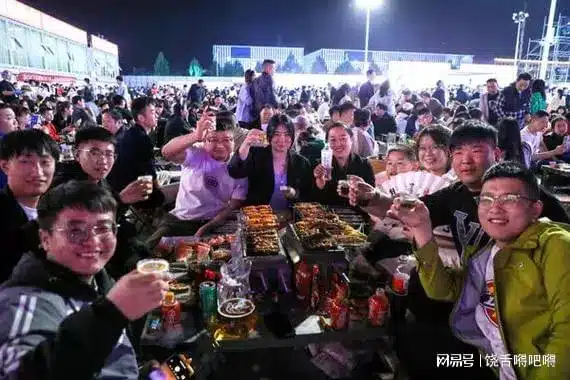
Zibo crowds, image via 163.com.
Since 2023, multiple cities have tried to replicate the success of Zibo. Although not all have achieved similar results, Harbin has done very well by becoming a meme-worthy tourist attraction earlier in 2024, emphasizing its snow spectacle and friendly local culture.
By promoting its distinctive take on malatang, Tianshui has emerged as the next city to captivate online audiences, leading to a surge in visitor numbers.
Like with Zibo and Harbin, one particular important strategy used by these tourist offices is to swiftly respond to content created by travel bloggers or food vloggers about their cities, boosting the online attention and immediately seizing the opportunity to turn online success into offline visits.
A Timeline
What does it take to become a Chinese ‘celebrity city’? Since late February and early March of this year, various Douyin accounts started posting about Tianshui and its malatang.
They initially were the main reason driving tourists to the city to try out malatang, but they were not the only reason – city marketing and state media coverage also played a role in how the success of Tianshui played out.
Here’s a timeline of how its (online) frenzy unfolded:
- July 25, 2023: First video on Douyin about Tianshui’s malatang, after which 45 more videos by various accounts followed in the following six months.
- Feb 5, 2024: Douyin account ‘Chuanshuo Zhong de Bozi’ (传说中的波仔) posts a video about malatang streetfood in Gansu
- Feb 13, 2024: Douyin account ‘Yibei Liangbaikai’ (一杯梁白开) posts a video suggesting the “nationwide popularization of Gansu-style malatang.” This video is an important breakthrough moment in the success of Tianshui as a malatang city.
- Feb – March ~, 2024: The Tianshui Culture & Tourism Bureau is visiting sites, conducting research, and organizing meetings with different departments to establish the “Tianshui city + malatang” brand (文旅+天水麻辣烫”品牌) as the city’s new “business card.”
- March 11, 2024: Tianshui city launches a dedicated ‘spicy and hot’ bus line to cater to visitors who want to quickly reach the city’s renowned malatang spots.
- March 13-14, 2024: China’s Baidu search engine witnesses exponential growth in online searches for Tianshui malatang.
- March 14-15, 2024: The boss of Tianshui’s popular Haiying restaurant goes viral after videos show him overwhelmed and worried he can’t keep up. His facial expression becomes a meme, with netizens dubbing it the “can’t keep up-expression” (“烫不完表情”).
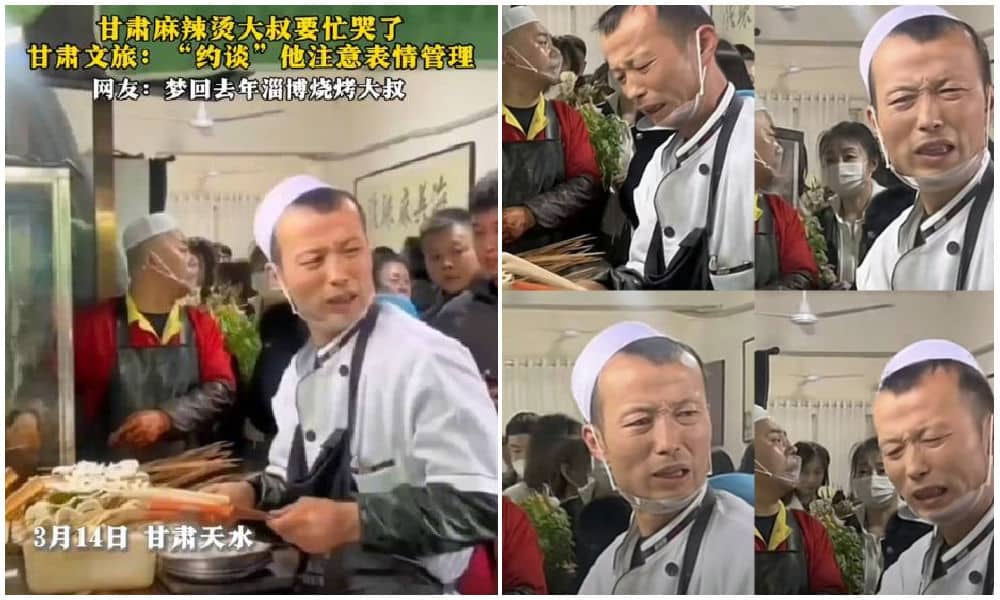
The worried and stressed expression of this malatang diner boss went viral overnight.
- March 17, 2024: Chinese media report about free ‘Tianshui malatang’ wifi being offered to visitors as a special service while they’re standing in line at malatang restaurants.
- March 18, 2024: Tianshui opens its first ‘Malatang Street’ where about 40 stalls sell malatang.
- March 18, 2024: Chinese local media report that one Tianshui hair salon (Tony) has changed its shop into a malatang shop overnight, showing just how big the hype has become.
- March 21, 2024: A dedicated ‘Tianshui malatang’ train started riding from Lanzhou West Station to Tianshui (#天水麻辣烫专列开行#).
- March 21, 2024: Chinese actor Jia Nailiang (贾乃亮) makes a video about having Tianshui malatang, further adding to its online success.
- March 30, 2024: A rare occurrence: as the main attraction near Tianshui, the Maiji Mountain Scenic Area announces that they’ve reached the maximum number of visitors and don’t have the capacity to welcome any more visitors, suspending all ticket sales for the day.
- April 1, 2024: Chinese presenter Zhang Dada was spotted making malatang in a local Tianshui restaurant, drawing in even more crowds.
A New Moment to Shine
Fame attracts criticism, and that also holds true for China’s ‘celebrity cities.’
Some argue that Tianshui’s malatang is overrated, considering the richness of Gansu cuisine, which offers much more than just malatang alone.
When Zibo reached hype status, it also faced scrutiny, with some commenters suggesting that the popularity of Zibo BBQ was a symptom of a society that’s all about consumerism and “empty social spectacle.”
There is a lot to say about the downsides of suddenly becoming a ‘celebrity city’ and the superficiality and fleetingness that comes with these kinds of trends. But for many locals, it is seen as an important moment as they see their businesses and cities thrive.
Even after the hype fades, local businesses can maintain their success by branding themselves as previously viral restaurants. When I visited Zibo a few months after its initial buzz, many once-popular spots marketed themselves as ‘wanghong’ (网红) or viral celebrity restaurants.
For the city itself, being in the spotlight holds its own value in the long run. Even after the hype has peaked and subsided, the gained national recognition ensures that these “trendy” places will continue to attract visitors in the future.
According to data from Ctrip, Tianshui experienced a 40% increase in tourism spending since March (specifically from March 1st to March 16th). State media reports claim that the city saw 2.3 million visitors in the first three weeks of March, with total tourism revenue reaching nearly 1.4 billion yuan ($193.7 million).
There are more ripple effects of Tianshui’s success: Maiji Shan Grottoes are witnessing a surge in visitors, and local e-commerce companies are experiencing a spike in orders from outside the city. Even when they’re not in Tianshui, people still want a piece of Tianshui.
By now, it’s clear that tourism marketing in China will never be the same again. Zibo, Harbin, and Tianshui exemplify a new era of destination hype, requiring a unique selling point, social media success, strong city marketing, and a friendly and fair business culture at the grassroots level.
While Zibo’s success was largely organic, Harbin’s was more orchestrated, and Tianshui learned from both. Now, other potential ‘celebrity’ cities are preparing to go viral, learning from the successes and failures of their predecessors to shine when their time comes.
By Manya Koetse
Independently reporting China trends for over a decade. Like what we do? Support us and get the story behind the hashtag by subscribing:
Spotted a mistake or want to add something? Please let us know in comments below or email us. First-time commenters, please be patient – we will have to manually approve your comment before it appears.
©2024 Whatsonweibo. All rights reserved. Do not reproduce our content without permission – you can contact us at info@whatsonweibo.com.
Subscribe

Weibo Watch: The Battle for the Bottom Bed

Zara Dress Goes Viral in China for Resemblance to Haidilao Apron

“Old Bull Eating Young Grass”: 86-Year-Old Chinese Painter Fan Zeng Marries 36-Year-Old Xu Meng

Chengdu Disney: The Quirkiest Hotspot in China

Where to Eat and Drink in Beijing: Yellen’s Picks

The ‘Two Sessions’ Suggestions: Six Proposals Raising Online Discussions

Top 9 Chinese Movies to Watch This Spring Festival Holiday

Party Slogan, Weibo Hashtag: “The Next China Will Still Be China”

From Pitch to Politics: About the Messy Messi Affair in Hong Kong (Updated)

“Old Bull Eating Young Grass”: 86-Year-Old Chinese Painter Fan Zeng Marries 36-Year-Old Xu Meng

Looking Back on the 2024 CMG Spring Festival Gala: Highs, Lows, and Noteworthy Moments

Two Years After MU5735 Crash: New Report Finds “Nothing Abnormal” Surrounding Deadly Nose Dive

More than Malatang: Tianshui’s Recipe for Success

Chengdu Disney: The Quirkiest Hotspot in China

In Hot Water: The Nongfu Spring Controversy Explained
Get in touch
Would you like to become a contributor, or do you have any tips or suggestions? Get in touch here!
Popular Reads
-
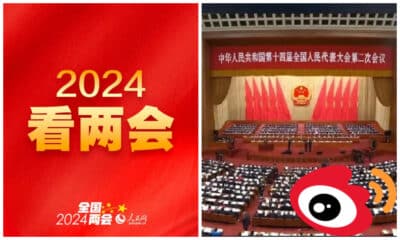
 China Insight2 months ago
China Insight2 months agoThe ‘Two Sessions’ Suggestions: Six Proposals Raising Online Discussions
-
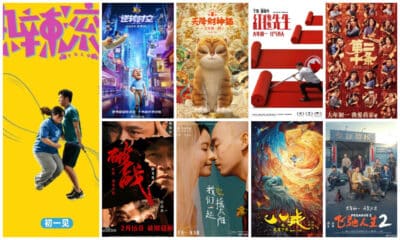
 China Arts & Entertainment3 months ago
China Arts & Entertainment3 months agoTop 9 Chinese Movies to Watch This Spring Festival Holiday
-

 China Media2 months ago
China Media2 months agoParty Slogan, Weibo Hashtag: “The Next China Will Still Be China”
-

 China World2 months ago
China World2 months agoFrom Pitch to Politics: About the Messy Messi Affair in Hong Kong (Updated)

